The 36th annual Eskom Expo for Young Scientists, taking place this week in Boksburg, drew over 500 learners from around the country and some international teams to exhibit their scientific projects.
To attend this expo, learners first have to enter one of 35 regional science expos across the country. The best projects are then selected to go through.
In 2016, some 1 365 schools and 8 972 learners participated nationally during the regional expos. The main expo saw 580 learners exhibit 488 projects.
Learners can enter their scientific investigation into one of the 24 categories ranging from animal sciences, mathematics and statistics, to renewable energy. The expo aims to encourage interest in STEM subjects.
Bronze, silver and gold medal winners are then selected from the main expo. Prizes include laptops, university scholarships and the opportunity to represent SA at international science fairs.
For the first time this year, the grand prize is a full scholarship valued at R1 million to study engineering in Germany, sponsored by Siemens.
This is the fifth year international learners have travelled to participate in the expo, with projects from Mexico, Kenya, Zimbabwe, Lesotho, Mozambique and Swaziland.
The expo has seen a growth of 43% school participation across the country this year, with 60% female participation.
Leo Dlamini, Eskom's acting group executive of transmission, risk and sustainability, says: "It is very exciting to see such enthusiasm towards science amongst our young people. Science is for the benefit of humanity and making this world a better place."
The expo is endorsed by the departments of public enterprises, science and technology, and basic education, and has also received recognition from the Presidency.
Exhibitors are aged 12 to 18, from grades five to matric.
ITWeb interviewed a selection of learners from the innovation, technology, maths and energy categories.
Enhancing signal
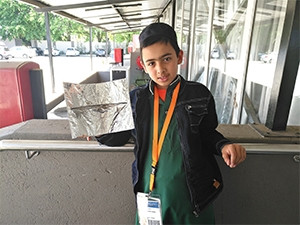
Uwais Abdool Gaffer from Middleburg Muslim School in Mpumalanga created a device to improve WiFi signal in his house. The 12-year-old is in grade five and has been working on the project for two years.
Echoing the frustrations of his generation, Gaffer says the idea was sparked when: "I was in my room watching a movie [on YouTube] and every five minutes it started buffering, and it was very irritating.
"So I wanted to find a way to increase the WiFi signal," says Gaffer.
He first made a solution using a glass but didn't feel this was good enough so designed his own tinfoil-encased contraption to increase the range and concentration of the signal.
Gaffer says this is a side project and he is thinking about studying accounting when he finishes school.
Stokvel gone digital
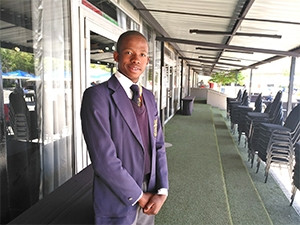
Lesedi Monnanyane from Postmasburg High School in the Northern Cape came up with a risk management tool for stokvel managers to see if a person who wants to borrow money from the group is credit-worthy.
The 15-year-old says the main problem with stokvels is the lack of access to information. The app uses data mining to work as a prospective app or Web site for stokvel administrators to make more informed decisions.
He was inspired after reading an article about someone who turned a stokvel into a bank, and because his family had lost money in stokvels before. He hopes to continue pursuing the idea after the expo and claim a share of the R49 billion industry.
Tuck in, turn off
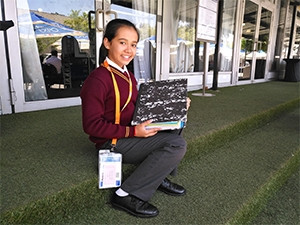
Ava Singh from ML Sultan Ladysmith Primary School in KwaZulu-Natal set out to establish how technology affected people's sleep. She studied 20 people and surveyed over 100.
The 12-year-old, who is in grade six, wanted to find out if people were willing to give up their technology addiction for a better night's sleep.
Singh found people who slept with their cellphones near them did not have good quality sleep because of notification disturbances and the small amount of intermittent light emitted from the device.
Cave exploration robot
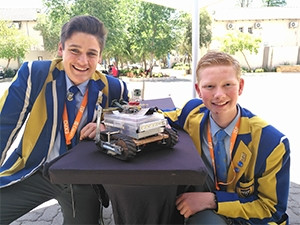
Erich Engelbrecht and Louis Deport from Waterkloof High School in Gauteng are both 15 and created a robot to go into caves that humans are unable to reach. They used completely reusable materials.
The grade nine learners are on their second prototype and have already tested it in five caves, including the Sterkfontein caves. A video of the expedition can be viewed here.
The first robot was made from Lego and components. The second version makes use of a plastic container, a small household torch strapped to the front with duct tape and an old Samsung Galaxy S4 strapped to the top to video the cave's roof.
The GrottoBot, as they have called it, runs on a Raspberry Pi and two 12-volt batteries.
The learners hope to study megatronics at Stellenbosch University after school.
Piezoelectric generator
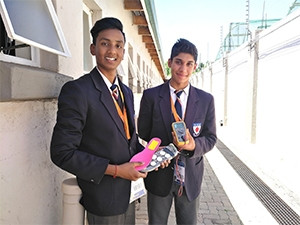
Devesh Jeaven and Thashil Naidoo from Northcliffe High School in Johannesburg developed a way for a battery pack to be charged while waking. The generator is built into the sole of a shoe and uses the piezoelectric effect to produce clean energy from walking.
The piezoelectric effect is the ability of certain materials to generate an electric charge in response to applied mechanical stress. The grade nine learners used the weight of a person to power a battery pack which can then be used to charge a phone on the go.
Little heat was produced during the process, say the learners, making it a safe way to generate power with the body. They also found the heavier the weight, the more power was produced.
They say their research shows an alternative source of energy can be created by incorporating the technology into roads.
Innovative backpack
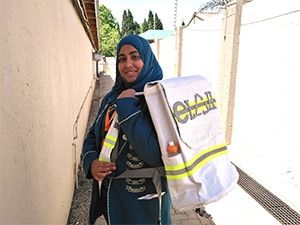
Nabeelah Bahadur, a 16-year-old from Secunda High School in Mpumalanga, created a cheap sustainable backpack for learners and general workers, after noticing people who could not afford proper backpacks often used plastic packets and had back problems.
The backpack, called ELAH, is made of recycled materials, has a reflector strip for people walking on roads (while still looking stylish, says Bahadur) and a solar panel on the strap for either charging a phone or using as a light while walking at night.
The grade 11 learner says the backpack supports the whole back, is waterproof and can carry up to 10kg. She tested it on a variety of people to see if it met their needs and improved the design in a second prototype.
She says it will cost less than R100 to make.
Share